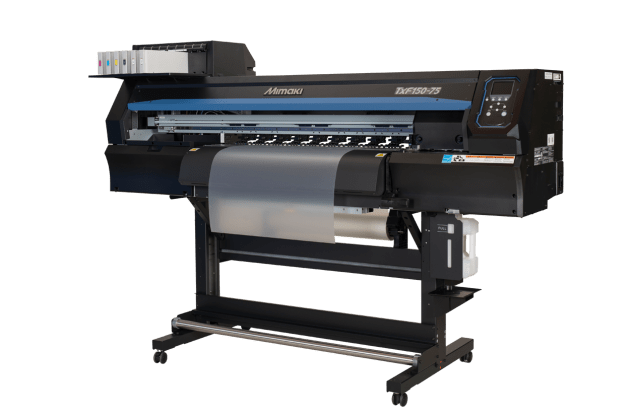MIMAKI SAYS DTF SCORES FOR GARMENTS
Digital print solutions developer Mimaki has launched its first direct-to-film print system for garments, and says it offers opportunities to all kinds of print businesses.

Mimaki’s first direct-to-film inkjet printer is the TxF150-75, an extension to its 150 series printers, with a maximum printing width of 80cm.
Marc Verbeem, supervisor product management, Mimaki, said, “The Mimaki TxF150-75 solution represents an exciting opportunity for Mimaki customers who are active in the decorated apparel sector, or are looking for the right solution to facilitate entry into the digital textile printing market.”
Mimaki says the model’s built-in ink circulation system and degassed ink pack are resolutions to common direct-to-film challenges such as poor ink ejection and white ink clogging. The new printer also includes core Mimaki features including NCU (Nozzle Check Unit) and NRS (Nozzle Recovery System) for what it says is stable, uninterrupted print production.
Operating in harmony with the textile printer itself is Mimaki’s Eco Passport by Oeko-Tex, certified water-based pigment textile inks, formulated for the TxF150-75. The ink and printer are coupled with Mimaki’s RasterLink7 rip software.
Mimaki has collaborated with Adkins to develop an 80cm wide powder shaker cure unit to complete the direct-to-film printing solution. Mimaki says by offering the printer and post-processing unit at 80cm wide, print businesses can print larger garments with less waste and quicker production times.
According to Verbeem, direct-to-film technology is having a transformative impact on the apparel decoration space. He says it provides a simple and affordable garment printing process that facilitates vibrant, dynamic, full-colour designs with a durable print. It opens up opportunities for digital print service providers to expand their product offerings in the textile industry, their network of potential customers, and thanks to the versatility of the process, expand the range of fabrics they can print on.
He said, “As its popularity grows in the textile sector, Mimaki recognised the need for a quality solution that uses our core technologies to take the process to the next level, combined with our well-established manufacturer support.”
Direct-to-film printing is the process of digitally printing directly onto a special transfer film sheet. The printed film is subsequently sprinkled with a hot-melt powder and heated. Once the transfer sheet is cured and dried, it can be heat-pressed onto a variety of fabrics to create premium transferred designs for customised merchandising, sportswear, and an array of other promotional applications for the textile market. Traditional screen printing requires plate creation, which can be time-consuming. And, said Verbeem, “Screen printing does not match direct-to-film’s ability to produce vivid colours and quality details such as shapes, lettering, and motifs often sought after in the promotional and merchandising space for bespoke textiles.”
For Mimaki, the move into direct-to-film technology is a venture into a new segment. Verbeem said, “Why did we choose to go down this path? For one, we knew we could offer a market-leading solution with our core technologies and the technical proficiency of the digital printers in our textile portfolio. In addition to this, there is a market need for a stable, reliable direct-to-film printing solution; for a complex print process like this, a trusted partner with dependable aftercare is paramount. Mimaki’s reputation is synonymous with support, which is what direct-to-film customers can expect every step of the way.”



